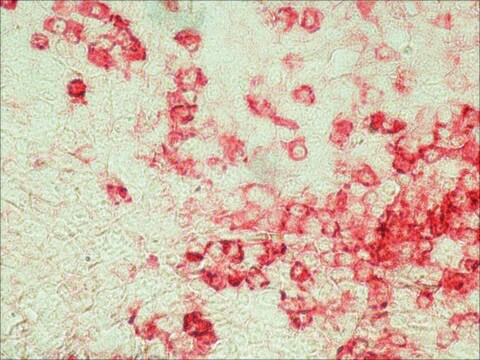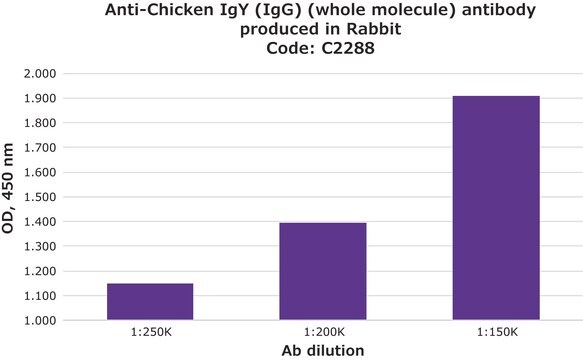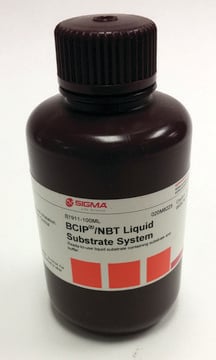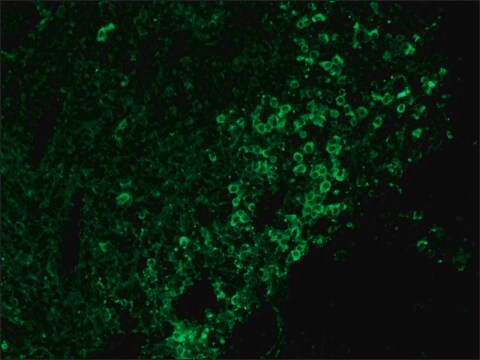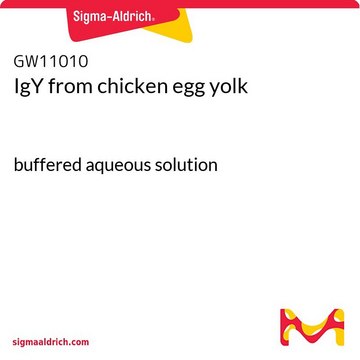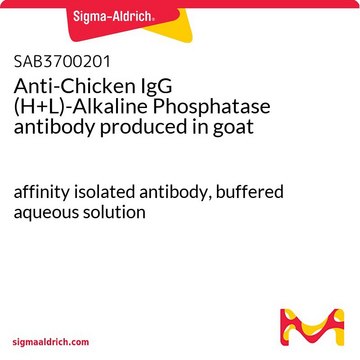추천 제품
생물학적 소스
rabbit
결합
peroxidase conjugate
항체 형태
affinity isolated antibody
항체 생산 유형
secondary antibodies
클론
polyclonal
양식
buffered aqueous solution
종 반응성
chicken
기술
direct ELISA: 1:30,000
dot blot: 1:160,000 (indirect chemiluminescence)
immunohistochemistry (formalin-fixed, paraffin-embedded sections): 1:1,000
배송 상태
dry ice
저장 온도
−20°C
타겟 번역 후 변형
unmodified
유사한 제품을 찾으십니까? 방문 제품 비교 안내
일반 설명
Chicken IgY is the major antibody found in chicken serum. Chickens generate a comparatively enhanced antibody response to mammalian antigenic proteins. These immunoglobulins do not bind to Fc receptors present in mammals and bacteria, and also do not interact with rheumatoid factors. Thus anti-chicken antibodies are useful analytical tools for various research applications.
Rabbit Anti-Chicken IgY (IgG) (whole molecule)-Peroxidase antibody binds to chicken IgG.
Rabbit Anti-Chicken IgY (IgG) (whole molecule)-Peroxidase antibody binds to chicken IgG.
면역원
purified chicken IgG
애플리케이션
Anti-Chicken IgY (IgG) (whole molecule)-Peroxidase antibody produced in rabbit has been used in indirect enzyme-linked immunosorbent assay (ELISA), dierct ELISA, dot blot and immunohistochemistry.
Proteins isolated from rabbit glomeruli by iron oxide magnetization were subjected to western blot analysis using HRP-conjugated rabbit anti-chicken IgY as the secondary antibody.
Rabbit Anti-Chicken IgY (IgG) (whole molecule)-Peroxidase antibody has been used for immunoprecipitation and western blot (1:2,000) assays. The antibody can also be used for direct ELISA (1:30,000), dot blot (1:12,000-1:15,000) and IHC (1:1,000) applications.
생화학적/생리학적 작용
Egg yolk IgY immunoglobulin acquired from hen have been studied extensively. It is useful in immunological assays and does interact with the rheumatoid factor.
물리적 형태
Solution in 0.01 M phosphate buffered saline, pH 7.4, containing 0.05% MIT
제조 메모
Prepared by the two-step glutaraldehyde method described by Avrameas, S., et al., Scand. J. Immunol., 8, Suppl. 7, 7 (1978).
면책조항
Unless otherwise stated in our catalog or other company documentation accompanying the product(s), our products are intended for research use only and are not to be used for any other purpose, which includes but is not limited to, unauthorized commercial uses, in vitro diagnostic uses, ex vivo or in vivo therapeutic uses or any type of consumption or application to humans or animals.
적합한 제품을 찾을 수 없으신가요?
당사의 제품 선택기 도구.을(를) 시도해 보세요.
신호어
Warning
유해 및 위험 성명서
Hazard Classifications
Skin Sens. 1
Storage Class Code
12 - Non Combustible Liquids
WGK
WGK 2
Flash Point (°F)
Not applicable
Flash Point (°C)
Not applicable
이미 열람한 고객
Germline polymorphisms and survival of lung adenocarcinoma patients: A genome-wide study in two European patient series
Galvan A, et al.
International Journal of Cancer. Journal International Du Cancer, 136(5), E262-E271 (2015)
Frequency of anti-Toxocara antibodies in broiler chickens in southern Brazil
Oliveira A, et al,
Revista Brasileira de Parasitologia veterinaria = Brazilian Journal of Veterinary Parasitology : Org?o Oficial do Colegio Brasileiro de Parasitologia Veterinaria, 27(2), 141-145 (2018)
Aline Sardinha-Silva et al.
PLoS pathogens, 15(6), e1007871-e1007871 (2019-06-22)
Infection of host cells by Toxoplasma gondii is an active process, which is regulated by secretion of microneme (MICs) and rhoptry proteins (ROPs and RONs) from specialized organelles in the apical pole of the parasite. MIC1, MIC4 and MIC6 assemble
Dae In Kim et al.
Proceedings of the National Academy of Sciences of the United States of America, 111(24), E2453-E2461 (2014-06-14)
Proximity-dependent biotin identification (BioID) is a method for identifying protein associations that occur in vivo. By fusing a promiscuous biotin ligase to a protein of interest expressed in living cells, BioID permits the labeling of proximate proteins during a defined
Production and purification of IgY antibodies from chicken egg yolk.
Amro W A, et al.
Journal of Genetic Engineering and Biotechnology, 16(1), 99-103 (2018)
자사의 과학자팀은 생명 과학, 재료 과학, 화학 합성, 크로마토그래피, 분석 및 기타 많은 영역을 포함한 모든 과학 분야에 경험이 있습니다..
고객지원팀으로 연락바랍니다.
